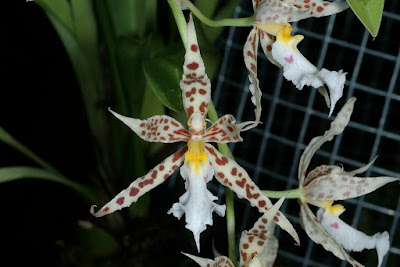Odontoglossum blandum is found from Ecuador to Peru. It occurs in Venezuela, Santander and Norte de Santander Colombia, Ecuador and Peru at the edge of mist forests at elevations of 1000 to 3000 meters above sea level.
Odontoglossum blandum also called as The Charming Odontoglossum, Oncidium blandum, is a species of the genus Odontoglossum. This species was described by Heinrich Gustav Reichenbach in 1870.
IDENTIFY ODONTOGLOSSUM BLANDUM ORCHID PLANT
Odontoglossum blandum is found from Ecuador to Peru. It occurs in Venezuela, Santander and Norte de Santander Colombia, Ecuador and Peru at the edge of mist forests at elevations of 1000 to 3000 meters above sea level.
It is a small sized, cool to cold growing epiphytic, lithophytic or terrestrial caespitose herb with elliptic-pyriform, complanate, sulcate pseudobulbs subtended by several foliar sheaths with linear-lanceolate, acute, carinate mid-vein, narrowing below into the conduplicate, petiolate base leaf.
The Charming Odontoglossum blooms in the spring and summer on an axillary, 17 to 19 cm long, slender, terete, few flowered inflorescence with a few distant narrow bracts and minute, ovate, long acuminate floral bracts arising on a mature pseudobulb. The flowers have a pleasant honey-like smell. Sepals and petals nearly equal, less than an inch long, lanceolate, acuminate, of a creamy white sprinkled over with numerous crimson dots. Lip about the same length as the sepals, and of the same hue, but destitute of spots except at the apex, the central portion bearing a large crimson mark nearly in the form of the letter W; the lip's base is formed of two parallel blunt lamella out of which springs the main limb which is broadly ovate, curled and jagged at the edges and recurved and acuminate at its extremity; at the point of junction with the unguis or claw occur two horned falcate processes, between which a small tumor is interposed, at foot of which are two short and blunt horns. Column short, bifid, angular with three or four straggling cirrhi or filaments on either side.
ODONTOGLOSSUM BLANDUM ORCHID PLANT CARE AND CULTURE
Cultural information should only be used as a guide, and should be to be adapted to suit you. Your physical location; where you grow your plants, how much time you have to devote to their care, and many other factors, will need to be taken into account. Only then can you decide on the cultural methods that best suit you and your plants.
Light:
Odontoglossum blandum need a light level of 10000-15000 lux for mature plants, but less for young plants and when temperatures are high (70% shade cloth over summer and more light in winter). Leaves turn reddish blue if receiving too much light and leaf loss will occur if too sun damaged. Dark green leaves indicate insufficient light. A slight bronzing of the leaves and older bulbs indicates the light is good for flowering.
Temperature:
The Charming Odontoglossum should be grown under cool temperature conditions. In summer, the optimum temperature range is between 8°C and 26°C. In winter, it need a minimum nighttime temperature of 7 to 12°C, with daytime temperatures of 10 to 17°C. The diurnal difference between day and night is usually 8 - 10°C. In their natural environment night temperatures can fall to 5°C and although tolerant of low temperatures down to 0°C, they will not tolerate frosts.
Humidity:
This orchid prefer humidity levels between 55-75%; higher levels of 60-80% require good air movement especially in the cooler months. Plants can also tolerate humidity levels down to 40% which can be maintained or increased with morning and evening misting.
Substrate, growing media and repotting:
The Charming Odontoglossum are usually grown in pot using small bark (5-10mm) perlite potting mix (5:1) or in sphagnum moss and perlite (70:30) as substrate. Some growers place a layer of sphagnum moss on the top of the pot to reduce evaporation and keep the roots cool. They can also be grown in perlite with a layer of gravel on the top.
These plants should be repotted every year to every 2 years in spring or autumn when new growths are about half mature. They should be grown in small squat pots that allow more frequent watering. The base of the new growth should be planted about 1.5cm into the bark but no deeper. Keep bark barely moist until new roots appear then resume normal watering.
Watering:
Odontoglossum blandum like abundant water and require frequent watering in warmer months. They must never be allowed to dry out. During summer irrigation will be required every 2 -3 days, however during winter rates may drop to once every 10 – 14 days. Misting daily in very hot weather is recommended. To reduce leaf spotting, avoid watering in the heat of the day or late afternoon in warmer months. Also avoid wetting the leaves and water the pot, not the leaves.
Fertilizer:
This plant require frequent application of half to quarter strength fertilizer all year round but less in winter. Apply fertilizer every 2 weeks when growing actively but monthly when less active. They are not gross feeders and too much fertilizer will harm their roots and turn leaf tips brown. Use of high phosphorus or potassium fertilizers as plants approach flowering can increase flower count and substance.
Rest period:
Odontoglossum blandum do not a rest period to stimulate flowering nor in winter. But they need less water in the winter, especially if they grow under the conditions of a dark, short day that occurs in moderate latitudes. You can let the plants dry between the next watering, but you must not let the plants stay dry for a long time. Fertilization should be limited or should be completely abandoned until spring, when stronger watering resumes.















COMMENTS